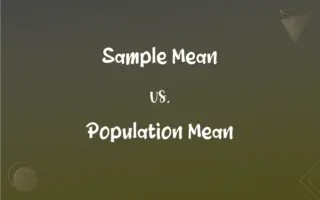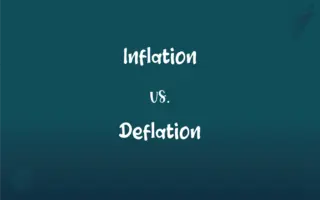Autonomous Demand vs. Derived Demand: What's the Difference?
By Janet White || Published on November 22, 2023
Autonomous demand is independent and primary, driven by customer needs or preferences, while derived demand originates from the demand for another product or service.

Key Differences
Autonomous demand arises independently, based on intrinsic consumer needs or desires, such as food or clothing. While, derived demand is contingent and arises from the demand for other goods or services, like the demand for steel driven by automobile production.
The influences on autonomous demand are broad, including cultural trends, personal preferences, or economic factors. Whereas, derived demand is specifically influenced by the demand in another market or sector, like the construction industry influencing the demand for construction equipment.
Autonomous demand tends to be more stable and predictable, as it is based on essential needs or established preferences. On the other hand, derived demand can be more volatile, fluctuating with changes in the market it depends on, such as the real estate market impacting the demand for home appliances.
Understanding autonomous demand is crucial for businesses in developing direct consumer products. Recognizing derived demand is essential for businesses in the supply chain or those producing complementary goods.
Autonomous demand can be a key driver of economic trends and consumer spending. Meanwhile, derived demand plays a critical role in the interconnectivity of different economic sectors, illustrating how changes in one area can impact others.
ADVERTISEMENT
Comparison Chart
Origin
Independent, based on direct needs
Dependent on the demand for another product
Stability
Generally more stable and predictable
More volatile, fluctuating with related markets
Influences
Personal preferences, essential needs
Demand in related markets or sectors
Business Focus
Direct consumer products and services
Supply chain, complementary goods, and services
Economic Role
Drives primary consumer spending
Indicates inter-sectoral economic dependencies
ADVERTISEMENT
Autonomous Demand and Derived Demand Definitions
Autonomous Demand
Primary market demand based on essential needs.
The housing market often experiences autonomous demand due to the fundamental need for shelter.
Derived Demand
Demand that exists because of the demand for another product.
The derived demand for steel increases with the growth in the automotive industry.
Autonomous Demand
Direct demand in the market, unaffected by other goods.
The autonomous demand for healthcare services is influenced primarily by demographic changes.
Derived Demand
Demand resulting from the needs of another sector.
The IT sector's expansion has created a derived demand for cybersecurity services.
Autonomous Demand
Independent demand not derived from other products.
The autonomous demand for smartphones has grown due to their integral role in modern life.
Derived Demand
Market demand dependent on another product's utility.
The derived demand for smartphone cases is directly tied to the sales of smartphones.
Autonomous Demand
Demand originating from consumer needs or preferences.
The autonomous demand for basic groceries remains consistent regardless of economic changes.
Derived Demand
Indirect demand linked to another product's consumption.
The construction boom has led to a derived demand for construction machinery.
Autonomous Demand
Demand influenced by personal choice and trends.
Fashion industries often drive autonomous demand through evolving styles and trends.
Derived Demand
A secondary demand influenced by a primary market.
The rise in online shopping has led to a derived demand for delivery services.
FAQs
What is autonomous demand?
Autonomous demand refers to the demand for goods or services that is not influenced by changes in other economic variables.
Can autonomous demand change?
Yes, but changes usually occur slowly over time due to cultural or societal shifts.
How does autonomous demand affect the economy?
It provides a stable base level of demand that can help stabilize an economy.
How is autonomous demand measured?
It's often assessed through long-term consumption patterns and trends.
Does autonomous demand drive economic growth?
It can contribute to steady growth but is less likely to drive rapid economic expansion.
What factors influence autonomous demand?
It is usually influenced by basic needs, preferences, and long-term societal changes.
Is autonomous demand constant?
It tends to be relatively constant, as it's not dependent on income, price, or other factors.
How does policy affect autonomous demand?
Economic policies can indirectly affect it by altering societal norms or basic needs.
What is derived demand?
Derived demand is the demand for a good or service that arises from the demand for another good or service.
What are examples of derived demand?
Demand for steel is often derived from the demand for automobiles.
Can marketing influence derived demand?
Marketing strategies can impact it, especially by influencing the demand for the primary product or service.
What are examples of autonomous demand?
Basic necessities like food, shelter, and clothing typically have autonomous demand.
Does derived demand impact employment?
Yes, it can significantly affect employment levels in industries related to the primary product or service.
Is autonomous demand predictable?
It's more predictable than other types of demand due to its relative stability.
Can derived demand fluctuate?
Yes, it's highly sensitive to the changes in the demand for the related good or service.
How is derived demand important in business?
Understanding derived demand helps businesses anticipate market changes and plan accordingly.
Is derived demand linked to the supply chain?
Yes, it's closely linked, as changes in demand can ripple through the supply chain.
How does derived demand work?
It occurs when the demand for one product or service boosts the demand for another related product or service.
How do companies forecast derived demand?
Companies analyze market trends and demand patterns for the primary product or service.
How do economic cycles affect derived demand?
Economic upturns and downturns can significantly impact derived demand due to their effect on the primary demand.
About Author
Written by
Janet WhiteJanet White has been an esteemed writer and blogger for Difference Wiki. Holding a Master's degree in Science and Medical Journalism from the prestigious Boston University, she has consistently demonstrated her expertise and passion for her field. When she's not immersed in her work, Janet relishes her time exercising, delving into a good book, and cherishing moments with friends and family.































































